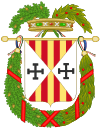Lamezia Terme
Lamezia Terme (Italian pronunciation: [laˈmeːtsja ˈtɛrme]), commonly called Lamezia (Italian pronunciation: [laˈmeːtsja]), is an Italian city and comune of 70,452 inhabitants (2013)[2] in the province of Catanzaro in the Calabria region.
Lamezia Terme | |
|---|---|
| Città di Lamezia Terme | |
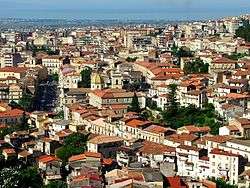 | |
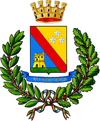 Coat of arms | |
Location of Lamezia Terme 
| |
 Lamezia Terme Location of Lamezia Terme in Italy 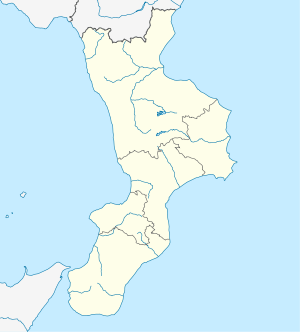 Lamezia Terme Lamezia Terme (Calabria) | |
| Coordinates: 38°58′N 16°18′E | |
| Country | Italy |
| Region | Calabria |
| Province | Catanzaro (CZ) |
| Frazioni | Acquadauzano, Acquafredda, Annunziata, Bucolia, Cantarelle, Caronte, Crozzano, Fronti, Gabella, Miglierina, Mitoio, Piano Luppino, San Minà, San Pietro Lametino, Sant'Eufemia Vetere, Santa Maria, Serra, Serra Castagna, Telara, Vallericciardo, Vonio, Zangarona |
| Government | |
| • Mayor | Commissar |
| Area | |
| • Total | 162.43 km2 (62.71 sq mi) |
| Elevation | 216 m (709 ft) |
| Population | |
| • Total | 70,699 |
| • Density | 440/km2 (1,100/sq mi) |
| Demonym(s) | Lametini |
| Time zone | UTC+1 (CET) |
| • Summer (DST) | UTC+2 (CEST) |
| Postal code | 88046 |
| Dialing code | 0968 |
| Patron saint | St. Peters and Paul |
| Saint day | 29 June |
| Website | Official website |
Geography
Lamezia is located on the eastern border of the coastal plain commonly called Piana di Sant'Eufemia, which was created by drying a wide marshy area.
The municipality borders with Conflenti, Curinga, Falerna, Feroleto Antico, Gizzeria, Maida, Martirano Lombardo, Nocera Terinese, Platania, San Pietro a Maida and Serrastretta.
History
The municipality of Lamezia Terme was formally created on 4 January 1968. Its territory includes those of the former municipalities of Nicastro, Sambiase and Sant'Eufemia Lamezia.
Nicastro
Nicastro's origins trace back to the 9th century, when Calabria was part of the Byzantine Empire, when a fortress called Neo Castrum ("New Castle") was created. A great Benedictine abbey, St. Eufemia, was founded here in 1062 by the Norman count Robert Guiscard. It was for a long time a fief of the Caracciolo family and, later, to the D'Aquino. The city was nearly destroyed after an earthquake in 1638 (more than 100 inhabitants died), and the abbey was turned into ruin. The castle, built by the Normans and enlarged by Emperor Frederick II and the Angevine kings, crumbled down. Floods and a further earthquake followed in the 18th century.
Nicastro experienced the highest rate of emigration during the late 19th and the early 20th century (some 8,000 citizens), as well as after the Second World War.
Sambiase
The baths of Sambiase are mentioned in the Roman itinerary Tabula Peutingeriana, indicating the village was an important destination of the time. A library edition of the map is kept at the Lamezia Terme Town Library in Lamezia Terme in its historical and specialist section, the Casa del Libro Antico (House of the Ancient Book).
The thermal baths of Sambiase were a great and famous place of comfort and rest for wayfarers, soldiers, and messengers. In the ancient times they were called Aque Ange. The Romans knew Sambiase by the name of Turres, or "towers", after the two observation towers situated there.
But Sambiase already existed during the ancient Greek period, first with the name of Melea (here they are placed in fact its ancient boundaries), and then Terina (of which numerous coins have been found again in the fraction Acquafredda and also the tesoretto of Sant'Eufemia preserved in the British Museum). With the fall of the ancient Greek empire, Turres was abandoned and devastated by the Ostrogoths.
Byzantine monks who escaped to Calabria from Sicily in the 7th century helped Sambiase become an exporter of farm products. The monks erected numerous monasteries, including that of St. Blase, from which the city's name derived, and taught the farmers to read and write. They developed alliances with great Byzantine cities in Taranto, Naples, and Gaeta, Italy, and Greece and Turkey. Thanks to their work, Sambiase succeeded in exporting its own products, including olives, grapes, corn, and wheat to the whole empire. They formed numerous orthodox monasteries and churches, such as the Sts. Forty Martyrs, Saint Sophia, and St. Constantine, important centers of culture comparable to the great European courts. By the 10th century, Sambiase had numerous churches, of which today only five remain.
Norman adventurer Robert Guiscard and his brother, Roger I of Sicily, stopped at the thermal baths together with their team of soldiers during the difficult attempt to conquer Calabria.
After the Norman conquest of Calabria and Sicily, Sambiase became home to an important and famous Norman university and was among the preferred places of the Norman sovereigns such as the Guiscards, King Frederick II and Manfred, King of Sicily, who also strengthened the power of some abbeys of Sambiase, such as St. Constantine.
With the Aragonese kingdom, Sambiase strengthened its own influence on the central government of Naples. Many students of the ancient university gained important court positions as mathematicians, astronomers and chamberlains.
Sambiase was a most important place for the Spanish and Italian economy.
Main point was the strictness and the share of Sambiase to the Italian wars of independence.
Notable figures born in Sambiase include the politician Giovanni Nicotera, the philosopher Francesco Fiorentino, and the poet [Franco Costabile].
Sant'Eufemia Lamezia
The current Sant'Eufemia Lamezia does not correspond to the ancient city location. The most ancient settlement was the Greek city of Terina, whose ruins were excavated in 1997. Sant'Eufemia Lamezia (nowadays Sant'Eufemia Vetere) was created upon a hill not long after the 1638 earthquake. The current quarter was built in the Fascist era after the drying of a marshy area.
Main sights
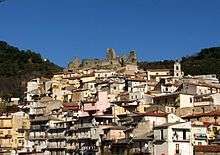

- The Castle is today an ensemble of ruins occupying the summit of a hill 320 metres (1,050 ft) high. It was built, according to some scholars,[4] by the Bruttii or by Greek colonists. The current structure dates probably from the Norman domination, although some structure existed at the time of the Ostrogoth king Teia. In 1122 Pope Callixtus II resided here for 15 days. Later, the castle was enlarged by Constance of Hauteville and his son Frederick II, as well as by the Angevines. The castle was heavily damaged by the earthquakes of 1609, 1638 and 1783, and subsequently abandoned.
- The Bastion of the Knights of Malta is a massive, well-preserved watchtower built in 1550 by the Spanish viceroy of Naples Pedro de Toledo. It was assigned to the Knights, who had a fief in the neighbourhood. Ruins of several other watchtowers are in the area.
- Near 'Sant'Eufemia, the ruins of the Cistercian abbey of Santa Maria di Corazzo can be seen. It was founded around 1060. Joachim of Fiore was an abbot here, and Bernardino Telesio wrote many of his philosophical works here in 1554.
- The abbey of the 40 Martyrs (Lamezia Terme - Sambiase), created in the 9th-10th century, is still active.
- The Diocesan Museum houses an Arab-Norman ivory case (12th century), paintings of 17th-18th centuries and other works.
- Eco-museum of Lamezia Terme in Sambiase.
- There are numerous churches of Sambiase di Lamezia Terme. The most important is Saint Pancrazio's church where there are some of Mattia Preti's pictures, fantastic statues and frescoes. It was a symbol of the new Sambiase in the 18th century.
People
- Carlo Rambaldi, special effects expert
- Felice Natalino, footballer
- Francesco Fiorentino, philosopher
- Giovanni Nicotera, patriot and politician
Transport
The central location of Lamezia Terme in Calabria has made it the main transport hub of the region. The city is situated adjacent to the A2 Salerno-Reggio Calabria Motorway, and the state road 288 runs to Catanzaro from Lamezia.
The central railway station, on the main line leading from Reggio to Naples, is a major terminal for goods traffic. Secondary branches connect to Catanzaro and Crotone.
Lamezia is the site of the Lamezia Terme International Airport, built in 1976. The airport has both national and international connections.
References
- "Superficie di Comuni Province e Regioni italiane al 9 ottobre 2011". Istat. Retrieved 16 March 2019.
- Istat data updated to 30/09/2012
- "Popolazione Residente al 1° Gennaio 2018". Istat. Retrieved 16 March 2019.
- "Lamezia Terme - Il castello". Lameziastorica.it. Archived from the original on 2013-05-03. Retrieved 2013-03-26.
External links
| Wikimedia Commons has media related to Lamezia Terme. |
- Official (in Italian)
- Historic portal of Lamezia Terme (in Italian)
